Florida's Oaks
Florida is home to many types of oak trees, both common and rare. They serve economic, aesthetic, and environmental purposes. Economically, oaks are used for timber, corks, tannins, dyes, and fuelwood. In the landscape, they provide visual interest with varying leaf types, acorns, and bark. Many put on a colorful show in the fall as well. Wildlife appreciate oaks as both a food source and cover.
There are two main categories of oaks: white and red. White oaks are considered “annual oaks” because their acorns are dropped during the year they are formed. Foliage tends to be rounder at the tip and lobes. The acorns are more palatable for wildlife and people because they have less tannins. White oaks are considered to be longer lived and more decay resistant than red oaks. On the other hand, red oaks (sometimes classified as black) drop their acorns the year after formation, making them “biennial oaks.” Leaves are typically pointed or have fine bristles. Their acorns are still consumed by wildlife, but they tend to be the second choice due to their higher tannin content.
Read on to learn more about some of Florida’s oaks, and perhaps find a few that would be suited to your yard!
The White Oak Group
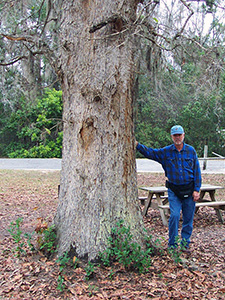
Bluff oak. UF/IFAS.
Bluff Oak
Although Quercus austrina isn’t widely available in nurseries, it is an excellent native to diversify your tree plantings if you can find it. It doesn’t require much pruning because it naturally grows straight with a round, symmetrical crown to a height of 40-60 feet. The deciduous leaves typically have five lobes and are lighter green underneath. Acorns are small, oval, and sometimes fuzzy at the tip. The most striking feature of bluff oak is its scaly, gray bark. Bluff oak thrives in zones 8A through 9B and prefers full sun and well-drained soil.
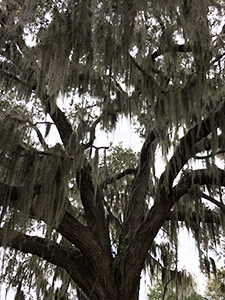
Live oak. UF/IFAS.
Live Oak
Quercus virginiana is an icon of the South, known for its winding branches draped with Spanish moss. This massive, native tree grows to a height of 60-80 feet with a spread of 60-120 feet. A pruning schedule is often required to develop a healthy structure. The small, oval leaves are dark green and glossy on top, and pale green and possibly fuzzy on the bottom. Live oak trees never drop all their leaves, unlike some other oaks. Acorns are elongated and grow in clusters. You can grow live oaks in zones 7B to 10B in well-drained soils in full to partial sun. With proper care, live oaks can live for centuries.
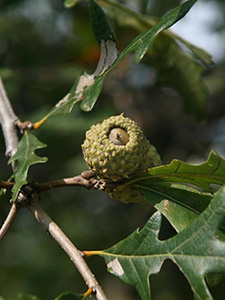
Overcup acorn. Chris Evans; University of Illinois; Bugwood.org
Overcup Oak
Quercus lyrata was named for its unique acorns which have scaly cups that nearly enclose them. This slow-growing native typically reaches a max height and spread of 30 to 40 feet. It has a twisted trunk that causes the reddish bark to have irregular ridges and sometimes look spiraled. Some pruning is necessary to achieve your desired clearance underneath. The leaves are dark green, leathery, and lobed with a lighter, fuzzy underside. They turn brown and fall in autumn. Squirrels, turkeys, wild hogs, and deer may all visit to snack on acorns. Overcup oak grows in zones 6A through 9A, tolerates most soil types, and appreciates full sun to partial shade. Look for it at native nurseries.
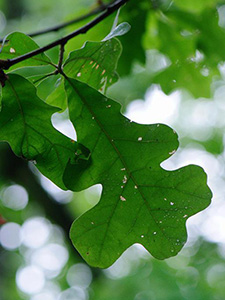
Post oak leaf. Vern Wilkins; Indiana University; Bugwood.org
Post Oak
Quercus stellata is known for its unique leaves that are vaguely shaped like a cross. They are deeply lobed, dark green, and shiny. The tree grows to be 40 to 50 feet tall and wide, with many spreading, winding branches. The trunk is covered with gray, chunky bark. Wildlife enjoy the acorns. Post oak grows in zones 6A through 9A, and is especially suited to dry, sandy soils that are low in fertility. Keep an eye out for this less-common oak in native nurseries.
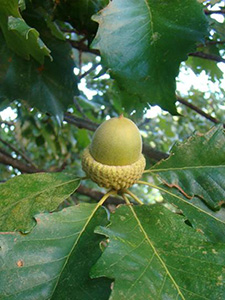
Swamp chestnut oak acorn. Franklin Bonner; USFS (ret.); Bugwood.org
Swamp Chestnut Oak
Quercus michauxii has several alternate common names, including cow oak and basket oak. It was named for its large, prolific acorns that cows eat and for its wood that is ideal for basketmaking. The leaves are deeply toothed and smooth green on top but silver and fuzzy on the underside. Pruning is required to keep the ideal form and mature trees will reach 60 to 80 feet tall. Swamp chestnut oak prefers acidic soil and tolerates both wet and dry locations in full sun. It can be grown in zone 9B and north.
The Red Oak Group
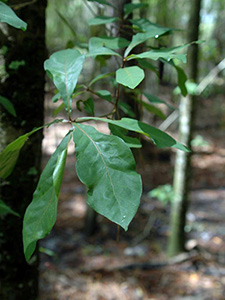
Laurel oak foliage. Chris Evans; University of Illinois; Bugwood.org
Laurel Oak
Quercus laurifolia is known for being a quick-growing shade tree. It has a dense, oval canopy and reaches a height of 60+ feet with a spread of 35 to 45 feet. The leaves are smooth, narrow, and shiny with no lobes. Laurel oak is semi-evergreen, which means that the leaves typically don’t turn brown and fall until early spring. Bark begins smooth and dark gray but develops splits as it ages. Proper pruning is important because laurel oaks are susceptible to decay and root rot, causing them to have a short life span of only 50 to 70 years. They are not always the best choice for urban areas because of this. Plant laurel oak in zones 6B to 10A in any soil type as long as the location is full sun to partial shade.
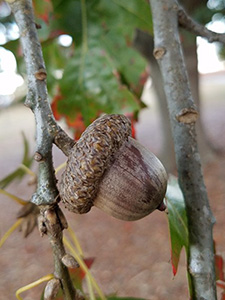
Shumard oak acorn. Rebekah D. Wallace; University of Georgia; Bugwood.org
Shumard Oak
Quercus shumardii is a popular native urban tree since it develops an attractive, open, rounded canopy and thrives in most soil types. It maxes out at 80 feet tall and 40- to 50-feet wide. The deciduous leaves are deeply lobed, with some of the lobes topped with bristles. In the fall, Shumard oak rewards the grower with a show of vibrant red and orange leaves. Wildlife enjoy the acorns, an attractive brown and 1.5 inches wide. The bark is gray and develops deep furrows with age. Proper pruning is essential for establishing a central leader; the tree will fill in over time. Shumard oak prefers full sun and grows in zones 5B to 9B.
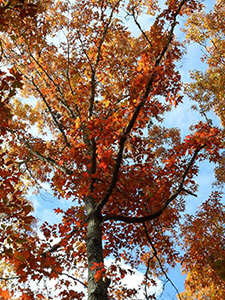
Southern red oak. David Stephens; Bugwood.org
Southern Red Oak
Quercus falcata is prized for being a durable shade tree. It grows to a height of 60 to 80 feet with a spread of 60 to 70 feet. The deciduous leaves are shiny and lobed, with the terminal lobe (at the tip of the leaf) being longer and narrower than the others. They turn brown and fall gradually in the autumn. The bark is dark gray to black, becoming deeply furrowed with maturity. Southern red oak grows in zones 7A to 9B in full sun. The soil should be well drained, acidic, and sandy or loam (not clay).
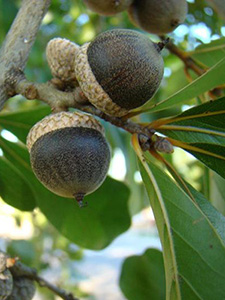
Water oak acorns. Franklin Bonner; USFS (ret.); Bugwood.org
Water Oak
Quercus nigra is often used for “natural” landscape designs and reaches a maximum height of 60 to 80 feet with an equal spread. It is native to the South and thrives in wet, swampy areas. The leaves are “spatula shaped,” meaning they are narrow at the base and wider at the tip. They are always green and smooth, but the margins of each leaf vary greatly. Acorns are prolific and popular with wildlife, although they will stain asphalt and concrete where they fall. The bark begins brown and smooth but becomes grayish black with rough furrows as it matures. The tree only lives to be about 30 to 50 years old and can start to break apart at maturity from rot. Proper pruning helps with this, but water oak is often not recommended for urban plantings because of rotting issues. Plant water oak in zones 6A to 10A in full sun to partial shade. Clay, sand, or loam soils are ideal.
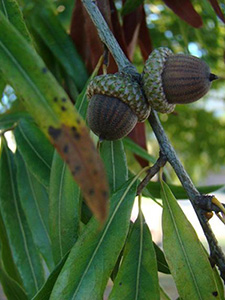
Willow oak acorns. Note the narrow leaves. Franklin Bonner; USFS (ret.); Bugwood.org
Willow Oak
Quercus phellos is a much-loved native shade tree that quickly shoots up to a height of 70 or more feet and a width of 40 to 50 feet. The canopy is pyramidal when young but becomes rounded when mature, with branches drooping to the ground. Willow oak is aptly named for its willow-like foliage that turns sunny yellow in the fall before being released. Prune off any double leaders that appear in order to create a sturdy form. Willow oak prefers wet soil that’s acidic or neutral. It will tolerate other soil types except alkaline. Plant this oak tree in full sun in zones 6A through 9B.
This is just a selection of Florida's oaks. We hope you will try growing one of these unique trees! As always, contact your county Extension office with any questions.

